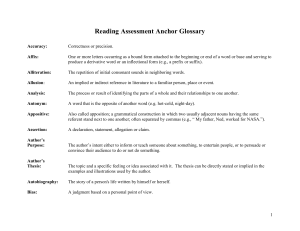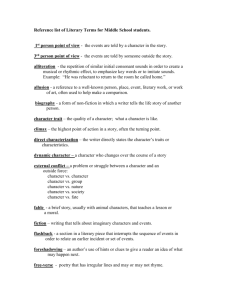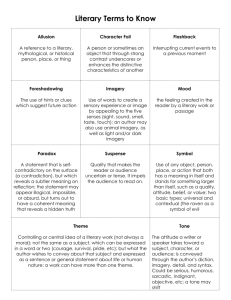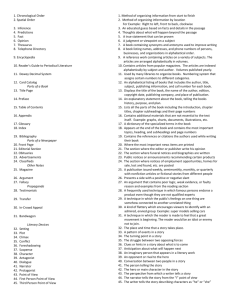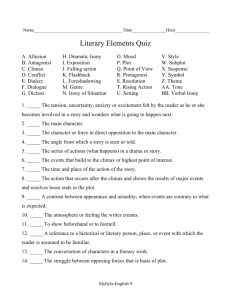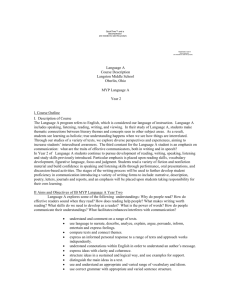Grades 5-6
advertisement
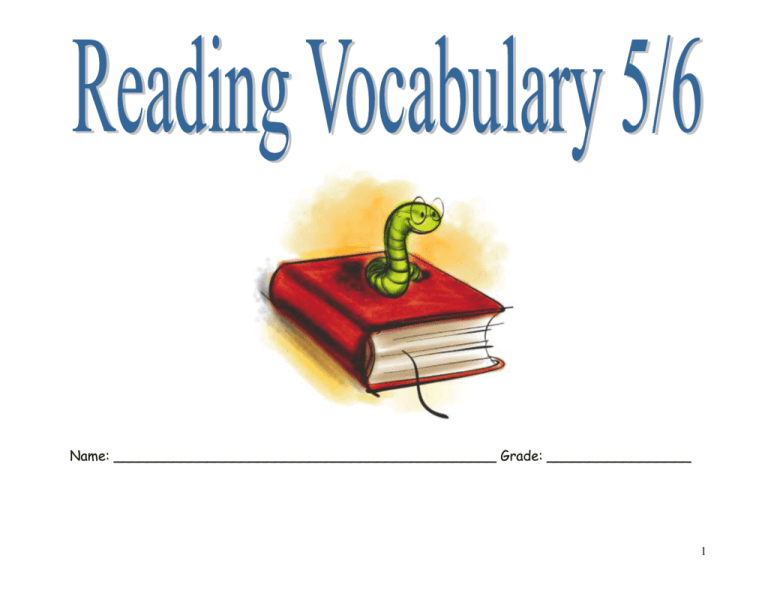
Name: _____________________________________________ Grade: _________________ 1 Reading Assessment Anchor Glossary Accuracy: Correctness or precision. Affix: One or more letters occurring as a bound form attached to the beginning or end of a word or base and serving to produce a derivative word or an inflectional form (e.g., a prefix or suffix). Alliteration: The repetition of initial consonant sounds in neighboring words. Allusion: An implied or indirect reference in literature to a familiar person, place or event. Analysis: The process or result of identifying the parts of a whole and their relationships to one another. Antonym: A word that is the opposite of another word (e.g. hot-cold, night-day). Appositive: Also called apposition; a grammatical construction in which two usually adjacent nouns having the same referent stand next to one another; often separated by commas (e.g., “ My father, Ned, worked for NASA.”). Assertion: A declaration, statement, allegation or claim. Author’s Purpose: Author’s Thesis: The author’s intent either to inform or teach someone about something, to entertain people, or to persuade or convince their audience to do or not do something. The topic and a specific feeling or idea associated with it. The thesis can be directly stated or implied in the examples and illustrations used by the author. Autobiography: The story of a person's life written by himself or herself. Bias: A judgment based on a personal point of view. 2 Biography: The story of a person's life written by someone other than the subject of the work. Cause and Effect: Cause statements stem from actions and events, and effects are what happen as a result of the action or event. Characterization: The method an author uses to reveal characters and their various personalities. Climax: The turning point in a narrative, the moment when the conflict is at its most intense. Typically, the structure of stories, novels and plays is one of rising action, in which tension builds to the climax. Compare: Placing together characters, situations or ideas to show common or differing features in literary selections. Compound Word: A word composed of two or more smaller words, the definition of which is a combination of the definitions of the smaller words (e.g., wallpaper). Conclusion: The ending of the story or the summarization of ideas or closing argument in nonfictional texts. Conflict/Problem: A struggle or clash between opposing characters, forces, or emotions. Content Specific Words: Core vocabulary that is peculiar to an academic discipline or subject. For example, the word precipitation is related to the discipline of science as it relates to weather. Context Clues: Information from the reading that identifies a word or group of words. Contrast: To compare or appraise differences. Conventions of Language: Mechanics, usage and sentence completeness. 3 Descriptive Text: Descriptive writing is intended to allow a reader to picture the scene or setting in which the action of a story takes place. Dialogue: In its widest sense, dialogue is simply conversation between people in a literary work; in its most restricted sense, it refers specifically to the speech of characters in a drama. Differentiate: Distinguish, tell apart and recognize differences between two or more items. Editorials: A newspaper or magazine article that gives the opinions of the editors or publishers; an expression of opinion that resembles such an article. Epic: A long narrative poem about the adventures of a hero of great historic or legendary importance. Evaluate: To examine and to judge carefully. Exaggeration: To make an overstatement or to stretch the truth. Explanatory Sentence: A sentence that explains something (i.e. passage, paragraph, word) Explicit: Referring to specific text that is included in the reading passage or in the directions. Expository Text: Text written to explain and convey information about a specific topic. Contrasts with narrative text. Fable: Narrative intended to convey a moral. Animals or inanimate objects with human characteristics often serve as characters in fables. Fairy Tale: Short narratives featuring mythical beings such as fairies, elves and sprites. These tales originally belonged to the folklore of a particular nation or region, such as those collected in Germany by Jacob and Wilhelm Grimm. 4 Fallacies of Logic: See propaganda techniques Fiction: Figurative Language: Any story that is the product of imagination rather than a documentation of fact. Characters and events in such narratives may be based in real life but their ultimate form and configuration is a creation of the author. Language that cannot be taken literally since it was written to create a special effect or feeling. First Person: The "first person" or "personal" point of view relates events as they are perceived by a single character. The main character "tells" the story and may offer opinions about the action and characters that differ from those of the author. Flashback: A device used in literature to present action that occurred before the beginning of the story. Flashbacks are often introduced as the dreams or recollections of one or more characters. Fluency: The clear, easy, written or spoken expression of ideas; freedom from word-identification problems that might hinder comprehension in silent reading or the expression of ideas in oral reading. Focus: The center of interest or attention. Folktales: A story originating in oral tradition. Folktales fall into a variety of categories, including legends, ghost stories, fairy tales, fables and anecdotes based on historical figures and events. Foreshadowing: A device used in literature to create expectation or to set up an explanation of later developments. Free Verse: Poetry that lacks regular metrical and rhyme patterns but that tries to capture the cadences of everyday speech. The form allows a poet to exploit a variety of rhythmical effects within a single poem. 5 Generalization: A conclusion, drawn from specific information, that is used to make a broad statement about a topic or person. Genre: A category used to classify literary works, usually by form, technique or content (e.g., prose, poetry). Graphic Organizer: A diagram or pictorial device that shows relationships. Headings, Graphics and Charts: Any visual cues on a page of text that offer additional information to guide the reader’s comprehension. Headings typically are words or phrases in bold print that indicate a topic or the theme of a portion of text; graphics may be photographs, drawings, maps or any other pictorial representation; charts (and tables or graphs) condense data into a series of rows, lines or other shortened lists. Homophone: One of two or more words pronounced alike, but different in spelling or meaning (e.g., hair/hare). Hyperbole: An exaggeration or overstatement (e.g., I was so embarrassed I could have died.). Idiomatic Language: An expression peculiar to itself grammatically or that cannot be understood if taken literally (e.g., Let’s get on the ball.). Imagery: A word or group of words in a literary work which appeal to one or more of the senses: sight, taste, touch, hearing and smell; figurative language. The use of images serves to intensify the impact of the work. Implicit: Meanings which, though unexpressed in the literal text, may be understood by the reader; implied. Inference: A judgment based on reasoning rather than on direct or explicit statement. A conclusion based on facts or circumstances; understandings gained by “reading between the lines.” 6 Inflectional Ending: A form, suffix or element added to the end of a word that changes the form of the word to mark such distinctions as those of case, gender, number, tense, person, mood or voice. Informational Text: It is nonfiction, written primarily to convey factual information. Informational texts comprise the majority of printed material adults read (e.g., textbooks, newspapers, reports, directions, brochures, technical manuals, etc.). Irony: The use of a word or phrase to mean the exact opposite of its literal or usual meaning; incongruity between the actual result of a sequence of events and the expected result. Legends: A story about mythical or supernatural beings or events, or a story coming down from the past, especially one popularly regarded as historical although not verifiable. Limerick: A light or humorous verse form of five lines, of which lines 1, 2 and 5 rhymes and lines 3 and 4 rhyme. Limited view: In literature, a speaker is speaking either in the first person, telling things from his or her own perspective, or in the third person, telling things from the perspective of an onlooker. If the speaker is unable to know what is in any character's mind but his or her own, this is called limited view. Literary Conflict: The struggle that grows out of the interplay of the two opposing forces in a plot. Literary Devices: Tools used by the author to enliven and provide voice to the writing (e.g., dialogue, alliteration). Literary Elements: The essential techniques used in literature (e.g., characterization, setting, plot, theme). Literary Nonfiction: Text that includes literary elements and devices usually associated with fiction to report on actual persons, places, or events. Examples include nature and travel writing, biography, memoir, and the essay. 7 Main Idea: The main idea is the author’s central thought; the chief topic of a text expressed or implied in a word or phrase; the topic sentence of a paragraph. Metaphor: A figure of speech that expresses an idea through the image of another object. Metaphors suggest the essence of the first object by identifying it with certain qualities of the second object. An example is "But soft, what light through yonder window breaks? It is the east, and Juliet is the sun" in William Shakespeare's Romeo and Juliet. Here, Juliet, the first object, is identified with qualities of the second object, the sun. Meter: The repetition of stressed and unstressed syllables in a line of poetry. Mood: The prevailing emotions of a work or of the author in his or her creation of the work. The mood of a work is not always what might be expected based on its subject matter. Multiple-meaning Words: Words that have several meanings depending upon how they are used in a sentence. Narrative: Text which conveys a story or which relates events or dialogue; contrast with expository text. Nonfiction: Prose writing that is not fictional; designed primarily to explain, argue, instruct, or describe rather than entertain. For the most part, its emphasis is factual. Omniscient: The narrative perspective from which a literary work is presented to the reader from a "godlike" perspective, unrestricted by time or place, from which to see actions and look into the minds of characters. This allows the author to comment openly on characters and events in the work. Onomatopoeia: The use of words whose sounds express or suggest their meaning. In its simplest sense, onomatopoeia may be represented by words that mimic the sounds they denote such as "hiss" or "meow”. Paraphrase: Restate text or passage in other words, often to clarify meaning or show understanding. 8 Pattern book: A book with a predictable language structure and often written with predictable text, also known as predictable book. Personification: lawn.). An object or abstract idea given human qualities or human form (e.g., Flowers danced about the Phonics: The relationship between letters and sounds fundamental in beginning reading. Plot: The structure of a story. The sequence in which the author arranges events in a story. The structure often includes the rising action, the climax, the falling action and the resolution. The plot may have a protagonist who is opposed by an antagonist, creating what is called conflict. Poetic Purpose: Text with literary devices and language peculiar to poetry (e.g. stanza, rhyme, meter, etc). Poetry: In its broadest sense, writing that aims to present ideas and evoke an emotional experience in the reader through the use of meter, imagery, connotative and concrete words. Some poetry has a carefully constructed structure based on rhythmic patterns. Poetry typically relies on words and expressions that have several layers of meaning (figurative language). It may also make use of the effects of regular rhythm on the ear and may make a strong appeal to the senses through the use of imagery. The way in which an author reveals characters, events and ideas in telling a story; the vantage point from which the story is told. Point of view: Possessive: Prefix: Print Media: A form of a noun or pronoun that indicates possession. In English the possessive of singular nouns is usually formed by the addition of an apostrophe and “s.” A Prefixes are groups of letters that can be placed before a word to alter its meaning. Print media include such forms as newspapers, periodicals, magazines, books, newsletters, advertising, memos, business forms, etc. 9 Problem/Solution: An organizational structure in nonfiction texts, where the author typically presents a problem and possible solutions to it. Propaganda Techniques and Persuasive Tactics: Propaganda techniques and persuasive tactics are used to influence people to believe, buy, or do something. Students should be able to identify and comprehend the propaganda techniques and persuasive tactics listed below. 1. Name-calling is an attack on a person instead of an issue. 2. A bandwagon appeal tries to persuade the reader to do, think or buy something because it is popular or because “everyone” is doing it. 3. A red herring is an attempt to distract the reader with details not relevant to the argument. 4. An emotional appeal tries to persuade the reader by using words that appeal to the reader’s emotions instead of to logic or reason. 5. A testimonial attempts to persuade the reader by using a famous person to endorse a product or idea (for instance, the celebrity endorsement). 6. Repetition attempts to persuade the reader by repeating a message over and over again. 7. A sweeping generalization (stereotyping) makes an oversimplified statement about a group based on limited information. 8. A circular argument states a conclusion as part of the proof of the argument. 9. An appeal to numbers, facts, or statistics attempts to persuade the reader by showing how many people think something is true. Public document: A document that focuses on civic issues or matters of public policy at the community level and beyond. Reading critically: Reading in which a questioning attitude, logical analysis and inference are used to judge the worth of text; evaluating relevancy and adequacy of what is read; the judgment of validity or worth of what is read, based on sound criteria. Reading rate: The speed at which a person reads, usually silently. 10 Research: A systematic inquiry into a subject or problem in order to discover, verify or revise relevant facts or principles having to do with that subject or problem. Resolution: The portion of a story following the climax, in which the conflict is resolved. The resolution of Jane Austen's Northanger Abbey is neatly summed up in the following sentence: "Henry and Catherine were married, the bells rang and everybody smiled." Retell: A child is asked to recount in her/his own words a story or article that has just been read. The exercise encourages the youngster to think conceptually and look at the bigger picture, but also include details of character, plot, setting, conflict and resolution or main ideas and important supporting details. Rhyme: Identical or very similar recurring final sounds in words usually at the end of lines of a poem. Rhythm: The pattern or beat of a poem. Rising Action: The part of a story where the plot becomes increasingly complicated. Rising action leads up to the climax, or turning point. Root Word: A root word is one to which prefixes and suffixes can be added to form different words. These new words are derived from the root word and are called derivatives or derivations. The root word help, for example, can be built up into the derivatives helpful, unhelpful, helpless, helper and more. Satire: A literary tone used to ridicule or make fun of human vice or weakness. Self-monitor: A comprehension strategy; knowing or recognizing when what one is reading or writing is not making sense. Semantics: The study of meaning in language. Setting: The time and place in which a story unfolds. 11 Simile: A comparison of two unlike things in which a word of comparison (like or as) is used (e.g., She eats like a bird.). Sonnet: A lyric poem of fourteen lines whose rhyme scheme is fixed. The rhyme scheme in the Italian sonnets of Petrarch is abbaabba cdecde. The Petrarchian sonnet has two divisions: the first is of eight lines (the octave), and the second is of six lines (the sestet). The rhyme scheme of the English, or Shakespearean sonnet is abab cdcd efef gg. Source: Primary Source: Text and/or artifacts that tell or show a first-hand account of an event; original works used when researching (e.g. letters, journals). Secondary Source: Text and/or artifacts used when researching that are derived from something original (e.g. biographies, magazine articles, research papers). Story Maps: A visual representation of a story that provides an overview including characters, setting, the problem, and resolution or ending. Subject area: An organized body of knowledge; a discipline; a content area. Suffix: Suffixes are groups of letters placed after a word to modify its meaning or change it into a different word group, from an adjective to an adverb, etc. Summarize: To capture all the most important parts of the original text (paragraph, story, poem), but express them in a much shorter space, and - as far much as possible - in the readers own words. Style: How an author writes; an author’s use of language; its effects and appropriateness to the author’s intent and theme. Symbolism: A device in literature where an object represents an idea. 12 Synonym: One of two or more words in a language that have highly similar meanings (e.g., sorrow, grief, sadness). Syntax: The pattern or structure of word order in sentences, clauses and phrases. Target Words: Words that students are expected to know. Often students are asked to identify other words that are antonyms and synonyms of target words. Sometimes students are asked to identify the meaning of a target word given in context. Text Structure: The author’s method of organizing a text. Literary Structure: An organizational structure found in fiction or literary nonfiction (e.g., foreshadowing, flashback). Nonfiction Structure: An organizational structure found in nonfiction (e.g., sequence, question-answer, causeeffect, problem –solution, etc.). Theme: A topic of discussion or writing; a major idea broad enough to cover the entire scope of a literary work. Thesis: The basic argument advanced by a speaker or writer who then attempts to prove it; the subject or major argument of a speech or composition. Third Person: A perspective in literature, the "third person" point of view presents the events of the story from outside of any single character's perception, much like the omniscient point of view, but the reader must understand the action as it takes place and without any special insight into characters' minds or motivations. Tone: The attitude of the author toward the audience and characters (e.g., serious or humorous). Validity: Refers to statements that have the appearance of truth or reality. 13 Venn Diagrams: The Venn diagram is made up of two or more overlapping circles. In language arts instruction, Venn Diagrams are useful for examining similarities and differences in characters, stories, poems, events, processes and major ideas between two texts etc. Voice: The fluency, rhythm and liveliness in writing that make it unique to the writer. 14

